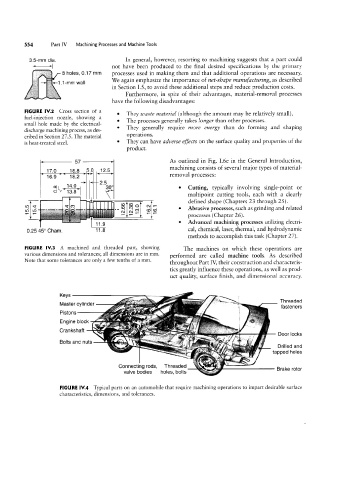Page 573 - 04. Subyek Engineering Materials - Manufacturing, Engineering and Technology SI 6th Edition - Serope Kalpakjian, Stephen Schmid (2009)
P. 573
'
S54 Part IV Machining Processes and Machine Tools
3.5-mm dia. In general, however, resorting to machining suggests that a part could
not have been produced to the final desired specifications by the primary
t
8 holes, 0.17 rnm processes used in making them and that additional operations are necessary.
1.1-mm wall We again emphasize the importance of net-shape manufacturing, as described
.» in Section I.5, to avoid these additional steps and reduce production costs.
Furthermore, in spite of their advantages, material-removal processes
have the following disadvantages:
FIGURE I\L2 Cross section of a
° They waste material (although the amount may be relatively small).
fuel-injection nozzle, showing a
° The processes generally takes longer than other processes.
small hole made by the electrical-
° They generally require more energy than do forming and shaping
discharge machining process, as des-
cribed in Section 27.5. The material 0Pef3tl0n5~
is heamreated Steer ° They can have adverse effects on the surface quality and properties of the
product.
57 As outlined in Fig. I.6e in the General Introduction,
gg 2.5 30° ° Cutting, typically involving single-point or
17 0 18 8 5_ 125 machining consists of several major types of material-
16_9 -|822 removal processes:
' multipoint cutting tools, each with a clearly
defined shape (Chapters 23 through 25).
3 E _ -- § § 3 3 E ° Abrasive processes, such as grinding and related
‘__ ‘_ 119 ‘_ " '_ _ '__' ° processes (Chapter 26).
Advanced machining processes utilizing electri-
0.25 45° Cham. 11.8 cal, chemical, laser, thermal, and hydrodynamic
methods to accomplish this task (Chapter 27).
FIGURE IY3 A machined and threaded part, showing The machines on which these operations are
various dimensions and tolerances; all dimensions are in mm. performed are called machine tools. As described
Note that some tolerances are only a few tenths of a mm.
throughout Part I\L their construction and characteris-
tics greatly influence these operations, as well as prod-
uct quality, surface finish, and dimensional accuracy.
Pistonsl Eléfeandeig
Keys
Master cylinder
Engine block
Crankshaft
Door locks
Bolts and nuts
Drilled and
tapped holes
Connecting rods, Threaded Brake rotor
valve bodies holes, bolts
FIGURE I‘L4 Typical parts on an automobile that require machining operations to impart desirable surface
characteristics, dimensions, and tolerances.

